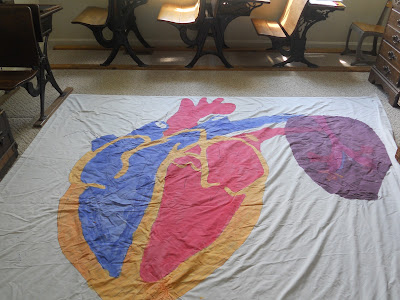Anatomy Co-op Ideas, Part II
 |
| Co-op kids with their "Guts" t-shirts |
Cow eyeballs to dissect! Hearts to walk through! DNA to extract from kiwi! Here are some of the activities we did in our co-op to go along with the content from the second half of Apologia's Human Anatomy and Physiology book.
Lesson 8: Circulatory System
At home my boys painted a heart on an old sheet. (I pinned the sheet to a large wall, and then used a computer projector to enlarge a diagram found on the web. After tracing the outline with a Sharpie, we took the sheet off the wall and the kids painted it. We have only one representative lung, and arrows on the other side showing how the blood moves.)
At co-op, the kids took turns walking the pathway of the blood, naming the chambers, veins, and arteries as they stood on them.
We also talked about the word circulation. I put several words that begin with "circ-" (circle, circumference, circumnavigate, circumscribe, circumlocution) on the board, and asked the kids what these words had in common, and what each means.
Then we dissected a cow heart. Very cool! You can find numerous Youtube videos which will help you prepare for this dissection. We had only one cow's heart, so the children weren't able to do as much of the dissection themselves as if we had had several, but it was still worthwhile.
Lesson 11: Senses: Cow Eye Dissection
OK, this was exciting! My very favorite science class this year, in fact! I'd asked the families to watch this video so the kids would be prepared for our dissection.
Cow eye dissection video from the Exploratorium
After watching that short video, it was amazing how well-informed and ready to jump into the dissection the kids were. In fact, this co-op got me thinking about how homeschoolers can and do use the flipped classroom model effectively in teaching. And this led to an article on that topic for Practical Homeschooling. But I digress.
We divided the children into pairs, gave them gloves and some basic instructions, and everyone eagerly set about their business. Dissection of cow eyes is so satisfying, largely because it is really easy to identify the major parts. No one was squeamish this time, either.
So much learning! So much fun!
Lesson 13: Lymphatic and Immune Systems
We talked about different kinds of
pathogens such as parasites, bacteria, viruses, and fungi.
Aside - Do you know that you have 10 x more microbial cells living in you than your own human cells? And that these bacteria may play significant roles in human health affecting everything from allergies to brain function? Increasingly, research has been coming out about the absolutely amazing microscopic flora that live inside each of us. In fact, some researchers wonder if there is a connection between the loss of gut diversity among Americans and the rise of diabetes, celiac disease, asthma, food allergies, and more. The Economist magazine says human bacteria ought to be considered a system of the body to be studied as the circulatory or respiratory system are. (And there's good reason to re-think our overuse of antibiotic soaps and hyper-emphasis on keeping our children away from dirt!) It will be fascinating to watch as scientists delve more into this microbial world living within us!
Anyway.
We zeroed in on bacteria, and talked about some of their shapes. The children then used pipe cleaners to illustrate the most common bacterial shapes: coccus, bacillus, and spirillum.
For our primary activity, I divided the children into three groups and assigned each one a scientist to learn about and figure out how to dramatize his discoveries. I gave each group a bag of props and costumes which they could use, along with a selections from the Core Knowledge What Your ___ Grader Needs to Know series. Here are the men I choose:
Anton van Leeuwenhoek: "Father of Microbiology" who discovered "animalcules" (microorganisms) using his microscopes. Props: magnifying glass, quill pen, microscope, powdered wig.
Edward Jenner: Developed the first smallpox vaccine. For our skit, we had a milkmaid, Edward Jenner, 8 year old James Phipps and his father. (Here's a Youtube cartoon about Edward Jenner. )
Alexander Fleming: Discovered penicillin.
 |
| Can it be? |
The skits were hilarious! (And hopefully instructive as well!)
 |
| Yes! It is! Penicillin! |
Lesson 14: Human Growth and Development
 Finally! An occasion to wear my DNA earrings !
Finally! An occasion to wear my DNA earrings !Extracting DNA from plant matter is surprisingly simple. We've done it with onions, split peas, and kiwi. For this co-op, we choose to use the latter.
Genome British Columbia has clear and easy to follow directions for extracting DNA from kiwi. Towards the bottom of the page there is a link to download instructions with pictures for each step. One change we made was to use an immersion blender to pulverize the kiwi instead of mashing in a zip bag. We also used graduated cylinders instead of a clear cup, which allowed us to visualize the contents better. The kids did this activity in groups of about three each. All of the teams were able to see the white filmy DNA strands, which became even easier to see over time. (My film card with our beautiful pics went belly up, so I can't show you. But this is easy to do at home, so try it!)
And to cap this last science co-op off, we made edible DNA models from licorice strands and mini marshmallows. Yum! (Or not, depending on your opinion of colored marshmallows.)
 |
| This co-op was also a good excuse to bring out our knit DNA model |
Anatomy Co-op Activities, Part I
Sources:
Exploring Creation with Human Anatomy and Physiology by Jeannie Fulbright and Brooke Ryan
KONOS Character Curriculum, Vol. 3, Cooperation: Human Body
Series of seven co-op lessons on human anatomy written by a homeschool mom
Ellen McHenry's Basement Warehouse - Tons of terrific ideas, games, and activities on this site! I've linked to the Human Anatomy ones, but she also has ideas for geography, history, and other science topics.
The Human Body: Lessons based on the Apologia text. Includes links, experiments, and printables. I didn't find this until after our co-op year was completed, but it looks like it might have some really good stuff especially for lower grade



Comments